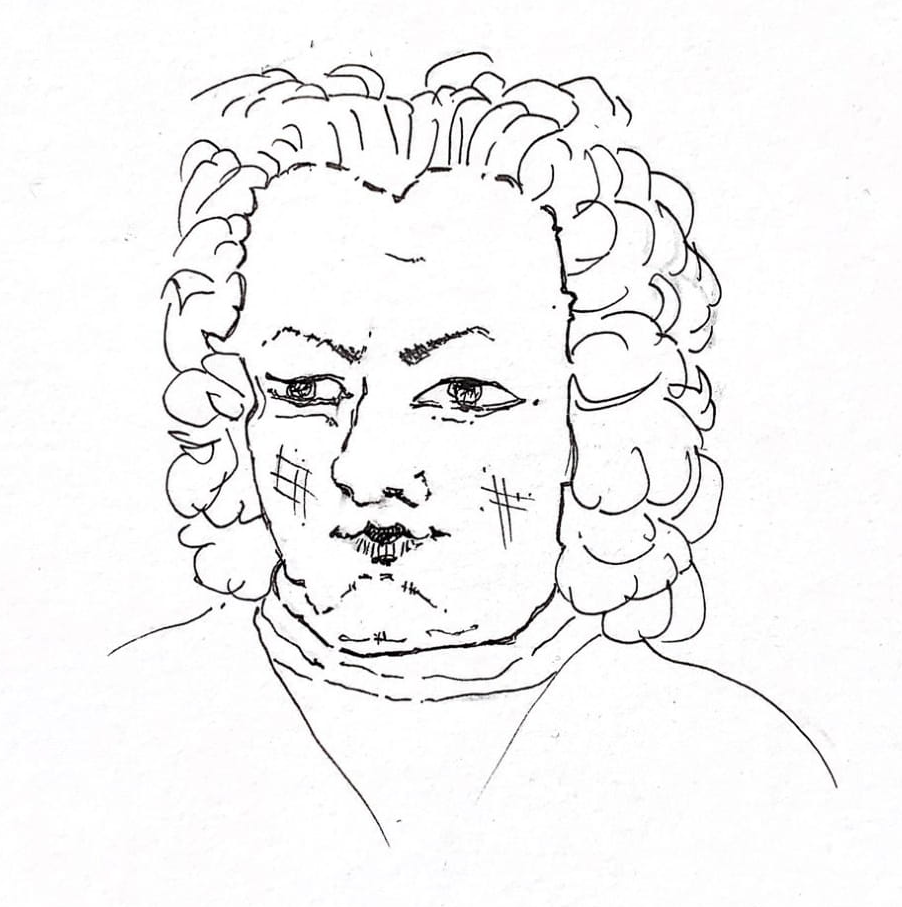This cantata of 5 movements, follows exactly the text of the 5 verse hymn up on which it is based and its tune is heard in each movement.
This hymn tune is popularly known to us today, by its first line, ‘O worship the king’.
The orchestration is festive,
-three trumpets + drums, combine with an oboe orchestra and continuo, with a 5-part chorus and soloists.
There is a possibility that this cantata may have been conceived for the festive installation of a new a town council.
1/Chorus -verse 1:
Praise The Lord,
the mighty King of honour.
My dear soul, that is my desire.
Gather yourself together in multitudes,
and wake up, psaltery and harps!
Let your music resound.’
This music is indeed this text. Its resounding splendour is apparent from the beginning, the concertante existing only to unpack the contents of itself.
Each of the 2-bar phrases, bars 1, through 4,
– which are repeated in G major, the dominant, bars 4, through 7, compliment perfectly, the holy combination, of ‘Praise’ and ‘Lord’ and this duality becomes a framework for other textual contents.
Note the appoggiatura between the first and second beats of the second bar.
The choral melody sits in majesty upon a counterpoint of instruments and vocals, itself nearly always prepared by bars of imitative fugato.
Each successive ritornello enlightens the text
– and no more so at bar 57, where spectacularly and with stealth, Bach takes us into an unknown and breath-taking world of musical instruments, a real moment of enlightenment,
where no vocal colours can speak or indeed make any relevant utterance or preparation and all that is needed here are two unison bursts,
– first the ‘wake-up’ and then the two instruments themselves.
Bars 66 through 72, without trumpets, surely gives us space, harps seemingly playing, with uncanny string colouration, lightly enhanced by some woody tones.
The last 26 bars are really resounding music.
2/Aria -verse 2:(chorale)
Praise The Lord,
– who governs all things so excellently,
and who bears you safely on His eagle’s wings.
In fact, who keeps you as you would keep yourself.
Have you not yourself understood these things?’
Continuo accompaniment only.
The flapping of eagle’s wings become the gentle undulation of the solo concertante violin’s strings and bow, three flaps to a bar.
The long introduction, with its metronomic flapping, prepares us for the, by now, well-known, yet slowly and naturally embellished choral tune,
sung unselfishly and without pomp of any sort, by the unassuming alto voice. Even the slightly surprising written out trills, bars 17/27, do not upset the slowly danced, three in a bar swing.
In preparation for ‘…who bears you safely on His eagle’s wings…’, the music twists and turns away, bar 30, landing on e minor, bar 38, at an an extended erhalt,
then quickly returns itself to a normal flight pattern, but in D major, 43.
The final confrontational line is delivered with out fuss,
– save a subtle shade of colouring than previously, toward e minor, at bar 51.
3/Aria -verse 3:
‘Praise The Lord,
-who adorns you finely,
-who has given you good health
-and guides you like a friend.
How often in your destresses,
has this merciful and gracious God,
spread his wings over you?’
This beautiful and sophisticated basso/soprano duet adds 2 x oboes to the previous movement, 5 parts in all, and the opening oboe shape, imitated by its partner, outlines the choral tune in its first, third and sixth notes.
Semiquaver appoggiaturas, from bar 5 onwards, increasingly appear in the evolving vocal shape, as these ‘destresses’, begin to surround and engulf.
The opening bars of each voice closely follow that of the opening bars of each oboe. Subsequent vocal entries are very similar.
From bar 53 onwards, some chromaticism prepares us for distress and adversity, but this dissipates, as the wings of grace and mercy spread increasingly over all,
– increased contrapuntal complexity, over all 5 parts, bar 59, including those increasing distresses, at bar 67.
4/Aria -verse 4:
‘Praise The Lord,
– who has clearly blessed your situation,
raining down love from heaven.
Consider what The Almighty can do,
He who treats you with all this love.’
This tenor aria features a continuo-only accompaniment, but where a lone trumpet,
-or oboe, will occasionally intone the choral melody. The vocal line, although in a minor key, nevertheless contains hints and snapshots of the choral.
The semiquavers, first appearing in the vocal clusters, bar 18, become, at bar 25 and onwards, the ‘…raining down (of) love from heaven…’,
– all this having been anticipated from the beginning and throughout Bach’s continuo bass line, where after rising-up in the first bar, the bass continually rains-down, throughout the introduction.
Some thoughtful considerations from bar 41, allow some time, for us to consider just exactly what The Almighty can do, this raining-down ‘motif’ being turned towards the thoughts and treats of love, which find their expression in the last vocal moments. The short trumpet-vocal imitation, bars 57 through 60, seem to reinforce these considerations.
5/Choral -verse 5:
‘Praise The Lord!
All that is within me, praise His name!
Let everything that has breath,
– and together with Abraham’s seed,
Praise Him!
He is your light, O soul.
Do not in any way forget it.
Those who praise Him,
finish with the Amen!’
This tutti performance includes independent trumpet and timp parts.
The increased, texture, now to eight parts,
– and particularly the imaginative first trumpet writing, adds weight, bringing this short cantata, to a memorably regal and brilliant close.
